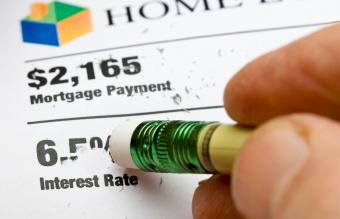
Consult a mortgage PMI calculator to find out what the total cost will be for your mortgage payment each month. PMI, or private mortgage insurance, is a type of insurance policy put in place to protect the lender. The purpose of PMI is to protect the lender in the event that you default on your home.
PMI Requirements
PMI is required when you have a low down payment. Your home is designed to act as collateral for the lender, so if you don't pay, they can take the house. Unfortunately, sometimes -such as when property values fall- a house isn't worth 100 percent of what the owner bought it for.
If your lender provided you with 100 percent financing for the home and property values then fall, your lender might not be able to recoup the full amount of the loan if it has to foreclosure. In addition, there are legal fees and other costs associated with foreclosure that the sale of the house would have to cover in the event of a default.
Because of these issues, lenders require you to put a down payment on the home so you own a part of it. This is referred to as your equity in the house. Typically, you are required to have a 20 percent down payment. If you have below this, you will generally be required to pay PMI.
Mortgage PMI Calculator
If you are considering buying a house and putting down less than 20 percent, you should input your purchase price and other information into a mortgage PMI calculator to learn just how much this insurance will cost you. There are several online calculators that allow you to estimate these numbers. For example, you can find PMI calculators at:
Many regular mortgage payment calculators that you can use to find out your monthly payments will also calculate PMI automatically if the numbers you input amount to less than a 20 percent down payment, so you may not need a dedicated mortgage PMI calculator to find out how much your total monthly mortgage payments will be.
Avoiding PMI
If you are considering buying a home, and you have less than 20 percent to put down, you can take steps to avoid PMI. The best option is to simply wait until you have the money available to put 20 percent down on the home. While this isn't an option for everyone, it is always a good idea to get your financial ducks in a row before you take on a large mortgage debt.
If this isn't an option for you, you may be able to take out two loans in order to avoid PMI. This is traditionally referred to as an 80-20 loan, since people would borrow 80 percent in a first mortgage and 20 percent on a second mortgage, however, there are other options for this creative financing. For example, if you have 10 percent to put down, then you could take an 80 percent first mortgage, a 10 percent second mortgage and put your 10 percent down. With these loans, you are able to keep your main loan to 80 percent of the value of the home, thus avoiding PMI.
However, not all lenders will permit an 80-20 loan, especially at times when the credit market is tight. In addition, the second mortgage may be at a higher interest rate than first mortgages, so your loan will cost you more in the long term.
Removing PMI
If you are currently paying PMI on your loan, you should be able to have it removed once you have paid off enough of your mortgage to owe only 80 percent of the value of the home. The key number here is the loan-to-value ratio. For example, if you have a loan for $100,000 and you owe $80,000, then you have an 80 percent loan-to-value ratio and you should no longer have to pay PMI.
Each lender has its own policy and procedures regarding lifting the PMI requirement. Your home may need to be reappraised in order to prove that you have achieved the required loan-to-value. Typically you will have to pay for this appraisal if it is required. If you believe you are close to having paid enough into your mortgage, contact your lender to find out exactly what you must do to be able to have the PMI requirement removed from your monthly payments.







